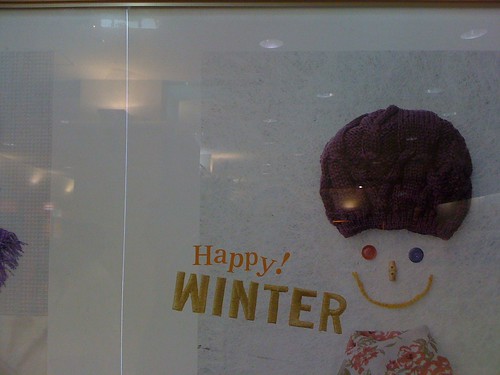 Passing through the underground shopping mall on the east side of Tokyo Station, I saw this sign. It says:
Passing through the underground shopping mall on the east side of Tokyo Station, I saw this sign. It says:× Happy! WinterI often see this pattern in Japanese English usage: two words, with the first followed by an exclamation point.
○ Happy Winter!
○ Have a happy winter!
○ Enjoy winter!
- 感嘆符 (かんたんふ) (n) (ling) exclamation point; exclamation mark; (definition from Edict)
Here's an example of something a native speaker might do:
 Even though I could find this image on the left, we really seldom wish people "happy __(season)__". The usual things, at least for Americans, are "Merry Christmas!" (not "happy Christmas"), "Happy Easter!", "Happy Valentine's", "Happy Halloween!", and "Happy Thanksgiving!". I've never been told or faced with advertising in the US wishing me "Happy Spring!" At least, I think I haven't.
Even though I could find this image on the left, we really seldom wish people "happy __(season)__". The usual things, at least for Americans, are "Merry Christmas!" (not "happy Christmas"), "Happy Easter!", "Happy Valentine's", "Happy Halloween!", and "Happy Thanksgiving!". I've never been told or faced with advertising in the US wishing me "Happy Spring!" At least, I think I haven't.The next holiday greeting I can give you is "Happy Groundhog Day", which is February 2. (explanation below from Eijiro on the Web)
groundhog ウッドチャック◆【同】woodchuckカナグラウンドゥハッグ、グラウンドホッグ、分節The weather this winter has made me really happy, at least here in Tokyo, so I'm hoping that winter will last a little longer.
Groundhog Day 恋はデジャ・ブ◆米1993《監督》ハロルド・ライミス《出演》ビル・マーレイ、アンディ・マクドウェル聖燭節、グラウンドホッグ・デイ、マーモットの日◆2月2日。米国ペンシルヴァニア州の祝日。冬眠していたウッドチャック(Groundhog)が2月2日に穴から出てきて、自分の影が見えるかどうかで春の訪れを調べるという伝説。影が見えると春はまだ遠くあと6週間ばかり冬が続くといわれる。ペンシルベニア州パンクサトーニー(Punxsutawney)ではこの日に恒例行事が催され、パンクサトーニー・グラウンドホッグ・クラブの会長がフィル (Phil)と名づけたウッドチャックを穴から出して天気予報を行う。

0 件のコメント:
コメントを投稿